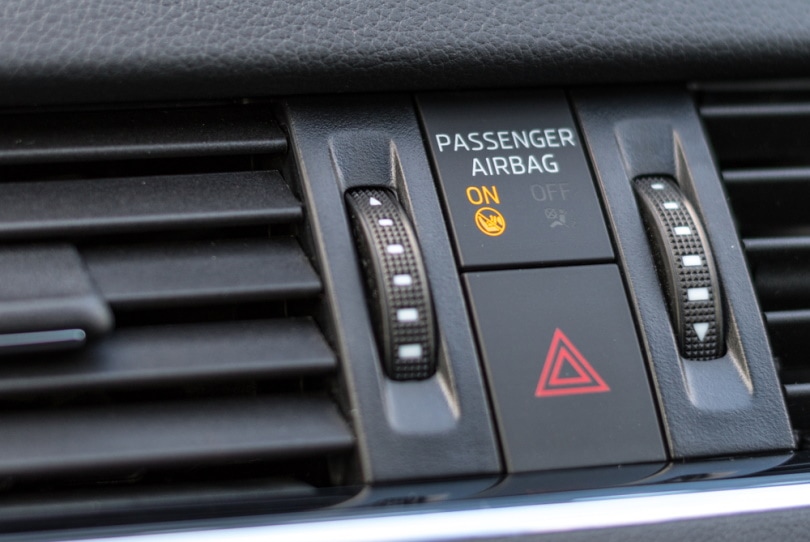How To Reset an Airbag Light: 10 Tips & Tricks
-
Samantha Reed
- Last updated:
Have you ever been driving around and noticed a light flashing on your dashboard? Maybe your pesky airbag light is finally starting to drive you crazy. If that sounds familiar, you might be wondering how you can get the light to shut off finally. Generally, when you start your car, the airbag light turns on momentarily as it completes an internal system check. However, the airbag light might not turn on, or it may even stay on and repeatedly blink. If you reach this stage, resetting the airbag light manually may be your best course of action.
While there are many ways to reset your airbag light, some may require a professional mechanic, so use your best judgment. Let’s explore some of the possible ways you can reset your own airbag light.
What Is an Airbag Light?
Typically, the airbag light can be located on the center dashboard in front of the driver. The airbag light will look like a small man sitting down with a bubble or circle in front of him. If this symbol or light is on in your car, the airbag light is usually trying to tell you that something is wrong with your vehicle’s airbag systems. If your system is A-Okay, the light shouldn’t even be showing on your dash.
If you get into a car crash or have an electrical malfunction, information is sent through the car to the module in charge of the total airbag system. This module also sends this data or code to the car’s computer, which is why sometimes having a code reader is handy.
Should You Reset the Airbag Light in Your Car?
If your airbag light is on, it’s most likely a sign of the system malfunctioning or experiencing a bug. If your system is malfunctioning, the airbag system will not deploy if you get into an accident. Your top priority should be figuring out the cause of the issue before you reset the light, as it can be detrimental in the long run. If you already know that the airbags are a common issue in your car, you can usually get away with just resetting the light and waiting for it to happen again.
However, there is always the possibility of a short in your airbag system that causes the light to stay on even without a system error. If the light only appears once and does not blink, resetting it is the best thing for you to do.
The 10 Steps to Reset Your Airbag Light
To reset your airbag light, here are some steps you should follow:
1. Turn your ignition on and off

The first thing you should do if you encounter an airbag issue is to turn your ignition on and back off again. Let your ignition switch on and wait for the airbag light to turn on normally. It usually stays lit for around 7 seconds before turning off. If the light does not turn back off after 7 seconds, immediately turn off the ignition and wait at least 3 seconds. Repeat the initial turn-on, wait for the light, and shut off steps once or twice before starting your engine. If done correctly, you’ll reset the airbag light, and it should shut itself off for good.
2. Restart your car and test drive
Sometimes, doing a simple ignition restart might not be enough. Like your phone, your vehicle may need to be turned on and off again. Follow the steps from number 1, and then take a short drive around the block. If the airbag light turns off after a quick spin around the neighborhood, your problem is likely solved.
3. Examine the passenger airbag switch
While the switch is only available in some models, it should still be one of the first things you check when attempting to reset your airbag light. It is possible someone turned it on by accident, causing the airbag light to stay on. If your car has an airbag switch, you can find it on the passenger side of the dashboard. Sometimes it’s located in the glove box or passenger door.
4. Inspect the seatbelts
You can also check whether your seatbelts are fastened or working correctly. Since the airbag light and system function through the car’s computer, the airbag light can turn on if it senses loosely or incorrectly strapped seatbelts. It can be so sensitive that it can even trigger if the seatbelt is not in use. You should always double-check your seatbelts and seatbelt sensors when trying to reset your airbag light.
5. Verify the passenger seat sensor

Certain cars may have an overly sensitive passenger seat. You may trip your seat sensor by doing something as simple as having a large box or container in the passenger seat. A heavier-than-average purse can even trigger it. If you trip the sensor in the passenger seat, your airbag light can come on. The easiest way to fix this is to remove the object from the passenger seat. If the light turns off, you know that was the root of your airbag light problem. The airbag light may even turn off if you fasten the passenger seatbelt.
6. Check with a code reader:
No, we don’t mean cracking the code like we are super spies though it may feel like that if you’re not a car person. If you are mechanically inclined, or if you happen to have one lying around, you can always plug a code reader into your car and see which code, if any, your vehicle is throwing you as a warning. Some code readers even have a built-in capability to do an automatic airbag light reset after checking your car’s computer.
7. Faulty airbag sensors

The sensors in your car are an essential tool in its function. Especially with more recent car models, sensors are playing an even bigger role. For example, sensors are what ensures your airbags deploy if you get into a car crash. If any of your car’s sensors corrode, break, or stop working, you may see your airbag light turn on. Sensors can act up for a variety of reasons, or even no reason at all. If this is the case with your airbag light problem, replacing the faulty sensor, control unit, or damaged parts may solve your issues.
8. Fix or replace a broken clock spring
Also known as a spiral cable, contact reel, or coil assembly, your car’s clock spring can cause your airbag light to turn on if it is damaged or broken. Not only is it one of the most common reasons your airbag light is flashing, but it is sadly also one of the most expensive to fix. This is one method you won’t be able to DIY. New clock springs can average around $400. You can save on the cost if you change the spring yourself, but it’s not worth the overall risk.
9. Make sure the airbag itself isn’t the problem

Although the rarest of the bunch, a faulty airbag should not be ruled out of your airbag light problems. If you discover that your airbag is the villain, you need to know that it is not something you can repair yourself. To fix your airbag, you will need professional help from a mechanic and a hefty chunk of cash. While the cost depends on your vehicle, you can assume you will be spending anywhere between $200 and $1,000 without labor fees.
10. Seek professional help
If you reach your Hail Mary pass and your problem is not solved, take your car to a mechanic. While it will be expensive, a mechanic can identify and solve the cause of your airbag light troubles. This is always an option whether you are a car-savvy driver or a new car owner.
Final Thoughts
While our list might not be the most extensive, it is a solid starting point of proven-and-tested methods to restart your pesky airbag light. You may not find the answer you are looking for, as some methods like the airbag switch might be incompatible with your specific vehicle. If attempting any of the fixes above, we highly recommend you first consult your car’s owner manual.
Featured Image Credit; zkolra, Shutterstock
Contents

